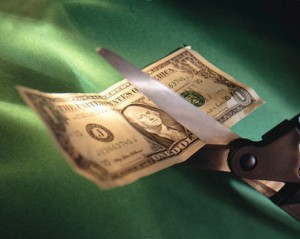Budgeting is the process of forecasting, monitoring, adjusting, and controlling future income and expenses. Budgets can be informal or formal. An informal budget can be an unwritten budget that includes remembering when the car payment is due. Formal budgets are written and include classes of expenses.
Formal budgets are often written because of a specific failure (out of control debt) or future need that requires achieving a specific amount of savings (your child’s college education). Quantitative types like the structure of formal budgets because they measure progress towards a specific financial goal and the movement towards the overall financial goal of financial independence.
An Annual Comparison Table compares the percentage of one year’s non-discretionary spending (for example, credit card, mortgage, and loan payments) to last year’s percentage of discretionary spending. Non-discretionary expenses are generally fixed costs for mortgages, loans, tuition, and so on. Non-discretionary expenses also include several types of variable expenses. These are expenditures that will be incurred but the amount will vary slightly for example semi-annual real estate taxes or quarterly water bills. Discretionary expenses are for the luxuries. Discretionary expenses can include vacations, entertainment, and gifts.
The Annual Comparison Table (shown below) for a sample family is a simplified budget that is divided into non-discretionary and discretionary expenses. The amount of non-discretionary expenses in 2008 as a percentage of total incomes was 80.8 percent. In 2009 the amount is 77.2 percent. This reduction in non-discretionary expenses is a significant improvement of 3.6 percent. And there is more good news. The Annual Comparison Table also indicates that savings increased by $2,095. The Annual Comparison Table is an excellent report card showing less debt and more savings for the sample family.
Tips for Not Straying from your Spending Pan
One approach to staying on a budget is to consider the budget a “spending plan”. Budgets can seem confining. Spending plans seem more flexible by focusing on what you can “spend”. The budget (or spending plan) starts with income from salaries, investments, self-employment, part-time jobs, and pensions then deducts fixed expenses and those pesky fixed /variable expenses (non-discretionary expenditures) and expenses that you have total control over (discretionary expenditures). Little can be done with non-discretionary expenses. Focus on discretionary expenses. A little maneuvering of discretionary expenses can frequently create opportunities to pay down credit cards, make automatic investments (for example, you can set-up an automatic payment plan for a mutual fund for as little as $25 per month), a fancy meal for your significant other, or set aside funds for a the purchase of a major appliance or anything else you might desire.
Here’s an approach that uses the percentages mentioned earlier. You can use this approach if you want to create this year’s budget and forecast next year’s budget. This is especially useful if you expect a decrease or increase in earnings. First, you’ll need to gather all your financial information. Next you will analyze this information to determine the dollar amounts spent. Then using the dollar amounts you will assign different items to various income or expense categories by month. Calculate the percentage of gross income that each category represents. You can use these percentages to forecast the annual budget for the next year
Give Your Budget a Reality Check
To give your budget a “reality” check you may want to compare your percentages of expenses to the averages listed by the US Department of Labor in their most recent report, US Bureau of Labor Statistics ConsumerExpenditures 2009 Annual Report(http://www.bls.gov/cex/csxann09.pdf). The following table shows a few examples of typical expense categories that are “money leaks”:
Table of Average Annual Expenditures
Average annual expenditures 100.0%*
Food at home 7.6%
Food away from home 5.3%
Shelter 20.5%
Apparel and services 3.5%
Transportation
Vehicles 5.4%
Gas and motor oil 5.2%
Healthcare 6.4%
Entertainment 5.5%
Personal insurance and pensions 11.2%
*Percent distribution of total expenditures by major category for all consumers 2009.
Another way to look at the Table of Average Expenditures is if you are spending 10 to 15 percent of your annual income on food away from home, you are spending two to three times the average. Let’s fine tune the Food Away From Home percentage in The Table of Average Annual Expenditures with a dollar amount. If your average annual expenditures are $49,067, the average annual amount you should be spending on Food Away From Home is $2,619 or about $50 a week. It is likely that if you buy lunch at work you are spending $50 a week. To stay within the average you would have to forgo going out to dinner.
The Entire Household must be Engaged in the Budget’s Success
Don’t overlook emotional resources and hurdles when developing a budget and trying to stay on budget. Human behavior has a large impact on the success of your budget. Individuals have important feelings about spending and saving. How we spend money is affected by how we were raised, our family backgrounds and cultures. Budgeting can cause tension within the family if there is poor communication. Therefore it is important to make budgeting a family affair. Make certain that each family member “buys into” where to spend and not spend.
To sum it up, budgeting is the process of projecting, monitoring, adjusting and controlling future income and expenditures. It is important to keep your spending under control and to save as much as you planned. Don’t forget to be flexible and adjust your budget if your family situation or job changes. Times change and you should be adjusting the budget accordingly.


